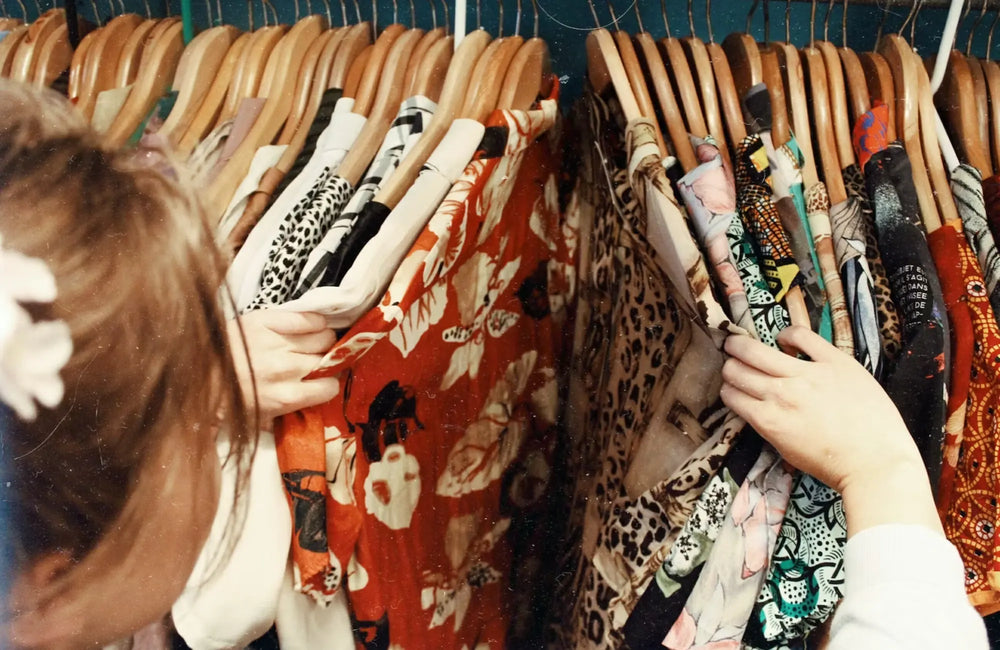
Slow Fashion vs Fast Fashion: What's the Difference?
|
If you're not happy with your first pair of underwear after trying it on, let us know.
We'll send a new size or color, or give you a refund. No returns needed.

Megan Lemon
|
When people ask me how I started living a more sustainable life, I always tell them I started with my closet. While it’s certainly not perfect (what is?), I’m very happy that nowadays, my closet features more slow fashion vs fast fashion.
But what’s the difference between slow fashion vs fast fashion? Is it about only buying clothes made with sustainable fabrics? Or is it about the ethics of a brand’s supply chain? And if slow fashion is so much better than fast fashion, why don’t all companies practice it? We’ll get into all of that and more below (like some tips for making your closet more sustainable)!!
Before we can fully jump into the differences between fast vs slow fashion, we need to understand what each of them are.
Slow fashion is about both sustainably and ethically producing clothing. It’s about creating more of a relationship between consumer and creator. When you buy slow fashion pieces, you’re typically more aware of how the piece was made, by whom, and with what impact on the environment. And while it’s a return to how we used to buy clothing, the term was created in opposition to the growing fast fashion movement.
Fast fashion is a business model that incentivizes brands to make the cheapest clothes possible. It revolves around a throwaway culture. Clothes are so cheap that you don’t feel bad about just throwing them away when they’re out of style or fall apart. And fast fashion is all about trends, especially trends that are only popular for a month or two. You don’t want to spend a bunch of money on a piece of clothing that will be old news in a month, right? So instead, people can buy trendy pieces for as low as $5, wear themfor a month, and then ditch ‘em as soon as the coolness factor runs out.
But unsurprisingly, that’s not the best business model for our planet, wallets, or society:
Fast fashion pieces are also usually made with some of the least sustainable materials like polyester and regular cotton. And the manufacturing processes end up polluting nearby water sources, which can be a major public health problem for local communities.
To understand this a bit more, let’s look at a slow fashion vs. fast fashion t-shirt. Starting with the material, a slow fashion t-shirt will be made with organic cotton vs cotton, which fast fashion brands use.
An organic cotton t-shirt will use only 186 gallons of water as opposed to the 2,168 gallons used for regular cotton t-shirts. Organic cotton t-shirts also don’t require pesticides and other harsh chemicals like regular cotton t-shirts, which is safer for the consumer and worker and better for the planet.
Moving past the materials, ethical production is more likely in brands that follow a slow fashion vs fast fashion business model. So your shirt will be made by skilled workers in a safe and healthy factory, instead of a sweatshop or exploitative working environment. Of course, a brand claiming to be slow fashion doesn’t automatically mean that they use ethical production practices, so do your research before taking out your credit card!
Then, let’s look into the actual wearing of the t-shirt. An organic cotton t-shirt sewn in a factory by trained seamstresses will be higher-quality and more durable. You can wear a slow fashion t-shirt for longer without it ripping, stretching out, or wearing holes into it. Meanwhile, a fast fashion t-shirt has a very short shelf-life and will likely end up in the landfill within a few months of purchase.
So, with this one imaginary fast fashion vs sustainable fashion t-shirt, you’ll have used less water, pesticides, and harsh chemicals, supported more ethical production, and prevented excess waste from going into a landfill.
Knowing all of this, you may be wondering why fast fashion still exists. However, slow fashion is not a perfect movement and is less accessible than fast fashion.
Slow fashion brands typically pay their workers more, use higher-quality (and therefore higher cost) fabrics, and construct their garments with more skill and precision. All of this is expensive, especially when compared to the extreme cost-cutting measures that fast fashion companies take.
These expenses do get passed onto the consumer. So when comparing a fast fashion vs slow fashion t-shirt, you’re going to pay more for the slow fashion option. And for more involved pieces of clothing like jeans, you’re probably going to be paying significantly more.
If you can afford to choose slow fashion vs fast fashion, that’s amazing. But a lot of us just aren’t in the position to do so. If you do have to buy fast fashion clothing sometimes, don’t beat yourself up for it. We’re all doing our best.
If you’re in a bigger body, you might find it difficult to buy slow fashion pieces. Many slow fashion brands just don’t offer bigger sizes, which is a huge problem. They might blame it on being a small company or not having the ability to offer a large range of sizes.
But at the end of the day, there are plenty of brands who offer custom sizing or plus-sizes. So there’s really no excuse. People in bigger bodies also deserve to buy high-quality, sustainable clothing.
A sustainable wardrobe comes down to more than just buying slow fashion vs fast fashion. There are plenty of things you can do to make your current clothes more sustainable and buy sustainably in the future.
Thrifting is a great way to grab new clothes without a huge impact on the environment or your wallet. You can find some pre-loved clothing that’s still great quality and will last for years. Plus, you’re saving clothing from ending up in a landfill!
A few things to keep in mind when shopping secondhand:
Have you ever thrown away a sweater because a moth ate a hole right through the sleeve? Or ditched a pair of jeans because the button snapped off? Well, now you don’t have to! Instead, learn how to repair clothing so you can keep wearing it long after the first hole appears or the button falls off.
Search on Youtube for visible mending techniques for ways to repair clothing that can actually make the piece a whole lot cuter than before! I love stitching over holes with fun shapes like stars and moons or hearts. It adds some personal pizzazz and keeps clothing out of landfills.
Also, if you get an irreversible stain on a piece of clothing, you can always dye it darker. Just look for low impact dyes and follow the bottle directions exactly.
And before you even need to repair, learn how to take care of your clothing, so it lasts longer:
Make your closet more sustainable and social by hosting a clothing swap party. Everybody should bring clothes that they’re tired of, don’t fit, or are otherwise going to get rid of. Then, you can shop from their giveaways. It helps to have a lot of people, so you can be certain all sizes and styles are represented.
With the popularity of sustainable clothing rising, many clothing brands are now motivated to claim sustainability. But you can’t always trust what they say because they may just be greenwashing (or falsely claiming certain sustainability and ethical standards). So it’s really important to do your research:
If you answered no to one or more of these questions, you might want to check out another brand that’s more transparent.
So, fast fashion vs slow fashion, what’s the difference? Slow fashion is more sustainably and ethically produced. It lasts longer and doesn’t follow trends as much. Meanwhile, fast fashion is about producing cheap clothing quickly so that you don’t have to feel guilty about throwing it out when it’s out of style (or in tatters). Fast fashion vs sustainable fashion is an ongoing issue in the clothing industry, and it’s important to support slow fashion companies.
It’s important to live as sustainably as you can. But it’s also important to not judge people who can’t do so. Slow fashion is not the most accessible movement for people in bigger bodies or with less disposable income to spend on high-cost clothing. As your first grade teacher probably said, keep your eyes on your own paper and just focus on doing what you can!
How do you make your closet more sustainable? Let me know in the comments below!
Get updates on restocks, new color and size releases, and upcoming product launches. You’ll also get a 15% discount on your first order of hemp underwear.











